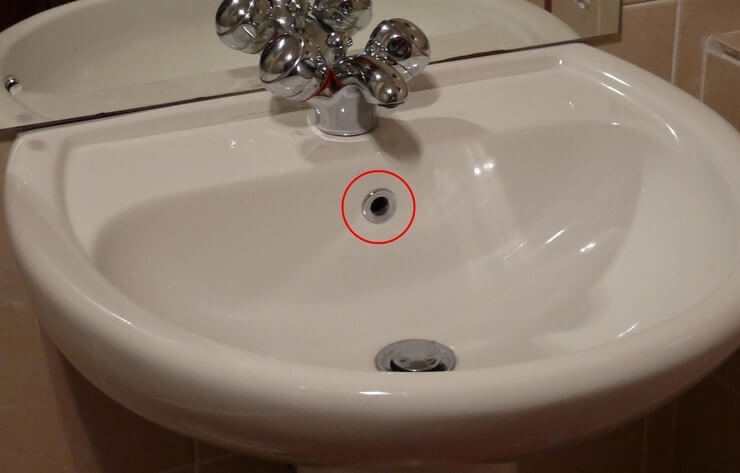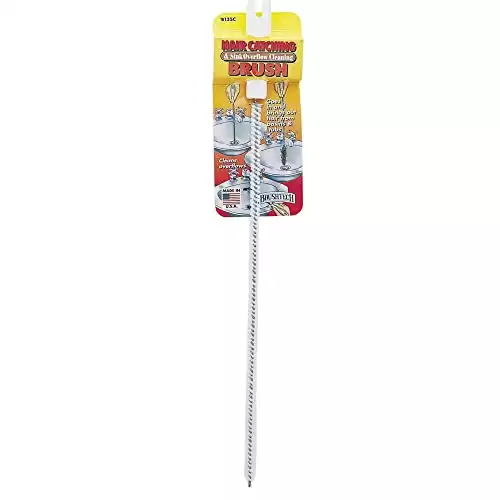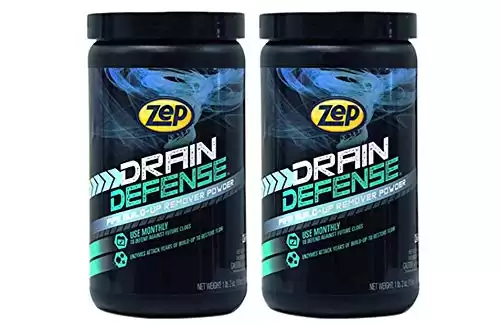Did you know that tiny hole in your bathroom sink is actually a hero in disguise, playing a vital role in preventing overflows?
Yet, without proper care, this hero can turn into a villain, becoming a source of different problems:
- Clogged drains that test your patience.
- A smelly sink, persisting even after a deep clean.
- A flooded bathroom floor, a reminder of that time you left the faucet running.
Why not spare a minute, don your gloves, and give this often-overlooked area the attention it deserves?
Join me as I share 5 proven methods to clean your bathroom sink overflow hole ensuring a cleaner, fresher environment with no room for unforeseen mishaps.

Why Do You Need to Clean the Overflow Hole?
The bathroom sink overflow hole is not merely for decoration.
It has essential functions, and if you have a clogged overflow hole, that’s a shortcut to a messy disaster.
It needs to stay clean and free of gunk or any buildup to serve its purposes.
There are several reasons why your bathroom sink needs an overflow hole.
Overflow Hole Prevents Water from Overflowing
If you closed the sink drain and accidentally left the water running, or in case of plumbing issues, it will overflow eventually.
As long as there’s no gunk or mold in your overflow drain, there’s a pretty good chance your bathroom won’t be flooded.
Overflow Hole Helps Improve Drainage
When there’s a lot of water covering the sink opening, there’s a suction effect with no air getting through the water.
As a result, the water down the drain flows very slowly.
Another essential function of overflows is to help the sink drain faster.
The overflow hole feeds air into the drainpipe through the overflow channel, so the water drains much faster.
5 Ways to Keep Sink Overflow Hole Clean and Stink-Free
As you can imagine, it’s imperative to keep your bathroom sink overflow hole clean and free from any debris.
Clogged overflows can create problems in the draining process and, not to mention, look ugly in an otherwise clean bathroom sink.
Plus, when mold starts growing in your clogged overflow, it will stink.
Good thing it’s easy to keep clean and stink-free sink overflows.
Here are some ways to keep your bathroom sink overflow hole clean.
1. Overflow Cleaning Brush
Gunk can start building up in the overflow drain and even the hole itself when it doesn’t get a regular cleaning.
This buildup can restrict the air and water flow, but a simple cleaning brush can help eliminate any debris in the overflow hole.
- Rigid and flexible for fitting into different drain shapes
- Can also be used to remove hair and gunk from tub and shower drains
A small cleaning brush with many bristles works especially great to loosen as much gunk as possible.
The bristles will also help pull out trapped debris that might be clogging the sink overflow.
Note: If you don’t have a cleaning brush around, a long plastic zip tie might work. It’s bendy enough to go around the curve of the overflow channel but also rigid enough to push out any blockage.
2. Rubber Hose
If you have a dishwasher hose or any rubber hose, that can also work for cleaning your bathroom sink overflow.
It’s an easy method to dislodge a substantial buildup in sink overflows.
Here’s how to use this method for cleaning the sink overflow hole.
- Fill the bathroom sink with water, keeping the water flow up to slightly above the overflow hole.
- Place one end of the rubber hose into the opening of the hole.
- Blow puffs of air into the opposite end of the hose.
- Drain the sink, then blow air into the hose again.
- Repeat as needed until the air blows through the overflow channel freely.
3. Enzyme Cleaners [Get Rid of Terrible Smell]
Brushing and blowing into the sink overflow can help dislodge any buildup.
But what if your overflow hole isn’t only clogged but also stinks?
If you leave clogged drains for too long, unwanted bacteria can grow, which causes a revolting stench in your bathroom.
The methods explained above effectively clean out the gunk and trapped debris in the bathroom sink overflows, but they won’t be able to kill the bacteria already housed in the drain.
To keep the sink overflow hole squeaky clean, you need to use enzyme cleaners.
These enzymes eat organic bacteria, helping you get rid of that awful smell in the overflow drain.
Enzyme eaters are available in liquid and powder forms.
Powder enzyme cleaners generally have a bit longer shelf life and are more effective after longer storage.
- Safe for PVC and most septic systems
- Removes foul odor
- Breaks down drain-clogging elements and removes bacteria
Here’s a video on how to use Zep Drain Defense (ex. DrainCare) to clean sink overflow and remove odor:
Pour the recommended amount into the overflow hole and leave it there overnight to give ample time for the enzymes to eat the bacteria.
The next morning, you can flush the overflow hole with warm water to get both dirt and smell out.
4. Liquid Cleaner
Another easy way to clean a bathroom sink overflow hole is by using a simple liquid cleaner.
You can make this solution by mixing equal parts of plain water and whatever kind of bleach you have at home.
Pour the liquid cleaner down the overflow hole and let it sit for a couple of minutes to do its work before flushing it down with water.
For this method, you can also use any ready-made liquid cleaner you have at home.
5. Baking Soda + Vinegar Solution
There’s no need to fret as a simple cleaning solution using your kitchen staples can eliminate both the gunk buildup and stinkiness of your bathroom sink overflow.
The soda and vinegar method is an excellent alternative if you are reluctant to use any bleach solution for cleaning bathroom sink drains.
Two common ingredients you can find in your kitchen, baking soda, and vinegar, can make a homemade cleaning agent that can keep sink overflows squeaky clean.
Take the baking soda, any kitchen vinegar, and a funnel, and follow this simple process to start cleaning your sink overflow.
- Use the funnel to pour 1 cup of baking soda into the overflow hole.
- Pour 1 cup of vinegar into the hole right after the baking soda.
- Let the cleaning solution sit in the overflow for at least 10 minutes.
- Flush out the overflow hole with water. Boiling water might work best for this to also help eliminate the vinegar odor.
To Sum It All Up
When you notice that your bathroom sink starts to stink, it’s either from the drain or the overflow hole.
If you find out that the overflow is the problem, there’s a buildup of gunk and trapped debris in there.
Not to mention, a kingdom of bacteria might already be living there.
Fortunately, the clog of gunk and stink in your bathroom sink overflow hole is easy to get rid of using most things you probably already have at home.



